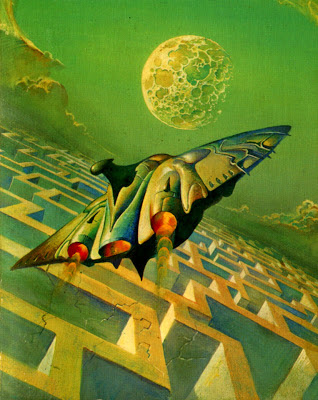Warlord Annual #6 (1987)
Written by Michael Fleisher; Art by Pablo Marcos
Synopsis: When last we checked in on Skartaris, the Apokolipsian invasion forces were attacking all the city-states. Lonar wants to use his mother box to call in reinforcements from New Genesis. He gets taken out, but Morgan manages to grab the mother box and escape.
In Kiro, Y’Smalla (disguised as Tara) makes her move to assassinated Machiste. She might have succeeded, had the real Tara not come to the rescue:
The two identical women fight a pitch battle. Y’Smalla, fearing she’s out-matched, escapes out a window.
Tara and Machiste join the battle outside and spot Desaad watching the proceedings with glee. They decide to drop in on him. A cowering, defeated Desaad delivers an ironic line:
The Apokolips army is forced to withdraw from Kiro, but Shamballah is still under siege. Morgan manages to get a message sent via the mother box before the Apokolipsians find him. His pistol jams and things look grim, but then the cavalry arrives in the form of a contingent of new gods. Living up to his nom de guerre, the Warlord takes command: He sends the new gods out to liberate the other Skartarian city-states while he takes one of the new Darkseidium Apokolips rifles and goes after Mantis, the leader of the Apokolipsian forces in Skartaris. Lonar worries about Morgan facing Mantis alone, but Morgan says he can handle it.
So we get a lot of snippets of fights among new gods: Lightray takes down Kanto in Bakwele. Orion puts a beat down on Kalibak in Kallistan. Forager disgraces Baron Vundabar in Kaambuka. Everywhere they go, they tell the people they come at the Warlord’s bidding, rehabilitating the image tarnished by Desaad’s shenanigans.
All the while, Morgan is maybe regretting taking on Mantis alone. His gun doesn’t work against him. All he can do is evade—which in the end, turns out to be enough. Mantis drains his power trying to hit him and is forced to return to his power pod.
Skartaris is freed. All the new gods boom tube back to their respective worlds. Lonar warns Morgan before he goes that Skartaris still has the ore Darkseid wants—and the lord of Apokolips doesn’t take defeat gracefully.
Things to Notice:
- Lonar's predictions about a return of Darkseid prove false. He doesn't show up again in the series.









.jpg)










